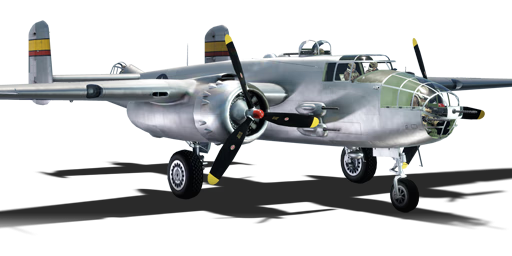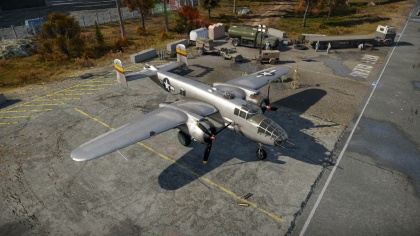B-25J-1
Contents
| This page is about the aircraft B-25J-1. For other uses, see B-25 (Disambiguation) |
Description
The B-25J-1 Mitchell is a Rank II medium bomber
with a battle rating of 3.7 (AB/SB) and 4.0 (RB) It was introduced in Update 1.29.
Simply put the archetype of the medium bomber is the B-25. It has versatile payloads (4 x 500 lb or 3 x 1,000 lb). It is faster than heavy bombers which can achieve over 340 mph in a dive to attack ground targets and as a bonus has offensive armament that allows it to fulfil the role of an air superiority bomber. Defensive guns placements include turrets & gunner stations. The B-25J sports heavy armament to include seven 12.7 Browning M2 machine guns. Also, this aircraft is durable, however, if the aircraft happens to sustain a direct hit to the fuel tank, there is a good chance of a fire followed by an explosion.
When flown properly, the B-25 Mitchell is among the best medium bombers in the game, with one of the most potent defensive armaments at its tier. If you enjoy strafing ground targets with the B-25, then consider researching the PBJ-1H with 8 forward facing .50 cal Browning M2 machine guns and a 75 mm cannon or the PBJ-1J sporting an impressive 12 forward facing Browning M2 machine guns, both of which are Marine versions of the B-25 airframe and possess all the facets that make the B-25 Mitchell such a legendary aircraft.
General info
Flight Performance
| Characteristics | |||||||
|---|---|---|---|---|---|---|---|
| Stock | |||||||
| Max Speed (km/h at 3,049 m) |
Max altitude (meters) |
Turn time (seconds) |
Rate of climb (meters/second) |
Take-off run (meters) | |||
| AB | RB | AB | RB | AB | RB | ||
| 420 | ? | 7,500 | 32.9 | ??.? | 4.1 | ??.? | 750 |
| Upgraded | |||||||
| Max Speed (km/h at 3,049 m) |
Max altitude (meters) | Turn time (seconds) | Rate of climb (meters/second) |
Take-off run (meters) | |||
| AB | RB | AB | RB | AB | RB | ||
| ? | ? | 7,500 | ??.? | ??.? | ?.? | ?.? | 750 |
Details
| Features | ||||
|---|---|---|---|---|
| Combat flap | Take-off flap | Landing flap | Air brakes | Arrestor gear |
| ✓ | ✓ | ✓ | X | X |
| Limits | ||||
|---|---|---|---|---|
| Wing-break speed (km/h) |
Gear limit (km/h) |
Combat flap (km/h) |
Max Static G | |
| + | - | |||
| 580 | 350 | 340 | ~4 | ~2 |
| Optimal velocities | |||
|---|---|---|---|
| Ailerons (km/h) |
Rudder (km/h) |
Elevators (km/h) |
Radiator (km/h) |
| < 300 | < 270 | < 350 | > 240 |
| Compressor (RB/SB) | ||
|---|---|---|
| Setting 1 | ||
| Optimal altitude | 100% Engine power | WEP Engine power |
| 524 m | 3,000 hp | 3,339 hp |
Survivability and armour
- 9.5 mm Steel plates throughout the cockpit
- 8 mm Steel plate behind the pilot
- 8 mm Steel plate under nose gunner
- 9.5 mm Steel plate behind the dorsal gunner
- 6.35 mm Steel plate behind beam gunners
- 38 mm Bulletproof glass in front of the tail gunner
- 9.5 mm Steel plates in front of the tail gunner
Armaments
Offensive armament
The B-25J-1 is armed with:
- 1 × 12.7 mm Browning M2 machine gun, nose-mounted (400 rpg)
- 4 × 12.7 mm Browning M2 machine gun, cheek-mounted (400 rpg - 1,600 total)
Suspended armament
The B-25J-1 can be outfitted with the following ordinance:
- 12 x 100 lb AN-M30A1 bombs (1,200 lb total)
- 4 x 250 lb AN-M57 bombs (1,000 lb total)
- 4 x 250 lb AN-M57 bombs + 8 x 100 lb AN-M30A1 bombs (1,800 lb total)
- 8 x 250 lb AN-M57 bombs (2,000 lb total)
- 2 x 500 lb AN-M64A1 bombs + 8 x 100 lb AN-M30A1 bombs (1,800 lb total)
- 4 x 500 lb AN-M64A1 bombs (2,000 lb total)
- 10 x 100 lb AN-M30A1 bombs + 1000 lb AN-M65A1 bomb (2,000 lb total)
- 3 x 1000 lb AN-M65A1 bombs (3,000 lb total)
Defensive armament
The B-25J-1 is defended by:
- 1 x 12.7 mm Browning M2 machine gun, nose turret (300 rpg)
- 2 x 12.7 mm Browning M2 machine gun, tail turret (600 rpg = 1,200 total)
- 2 x 12.7 mm Browning M2 machine gun, dorsal turret (400 rpg = 800 total)
- 1 x 12.7 mm Browning M2 machine gun, 2 x beam turret (250 rpg = 500 total)
Usage in the battles
In realistic battles (and arcade to some extent), it is highly recommended against exclusively bombing strategic bases and in general to not bomb from high altitudes. It was rarely used this way in combat, and it makes it very easy for enemy fighters to approach and attack you from your defenceless belly. Also, the bomber's maximum payload of 3 x 1,000 lb of bombs is not enough to destroy an enemy base in realistic battles, which is useless in regards to decreasing ticket count and, most importantly, does not help your team. Thus, leave base bombing to the British heavy bombers you will likely also encounter on your team, whose payloads vastly outclass yours, and instead - if you wish to help your team as much as possible - use your five nose-mounted Browning machine guns on ground targets. Ground target straffing is not only infinitely more exciting than base bombing, but it can also lower the enemy's ticket count drastically, therefore helping your team win. Fly at low altitudes and attack light pillboxes and soft targets with your guns. If you fail to destroy a target, then pitch up and use your turrets to finish it off. Save your bombs for targets your guns cannot kill, such as heavy tanks and heavy pillboxes; the bombsight is very helpful in doing this (something which the dedicated strafing variants such as the PBJ-1J lack). Make sure to use a fuse timer, 3 seconds should be enough when bombing at treetop level with 1,000 lb bombs.
When strafing, be sure to watch your radar at all times for any incoming enemies so you can adequately prepare for an attack. When being attacked, fly away from the assailant and try to get them on your tail, and manually open fire with your defensive guns, making sure to watch your tracers and adjust direction of fire, so they hit the target. Remember that turret guns will jam if fired for a long duration, requiring them to be reloaded, which usually takes almost twenty seconds, during which an attacker will most certainly kill you. If the reticle starts blinking, the guns are very close to jamming, so immediately stop firing and wait for the weapons to cool down. Many experienced players will attempt to utilise the dead zones on your belly and the arcs beyond your twin rudders in their attack. If you find an enemy doing this to you, then switch back to flight view and manoeuvre so that they are in the firing arcs of your guns again and try as much as possible to keep them out of your dead zones and, mostly, make their attack as difficult as possible. The attacker will then either eventually lose patience and try for a head-on, or you will get a successful snipe on their aircraft. It is also very advantageous to use the keyboard controls for pitch, roll, and yaw in the gunner view as it will allow you to make small manoeuvres while still concentrating on defending yourself, letting you, for example, dodge fire or roll/pitch/yaw and shoot someone in your dead zones. Also, use Universal belts for your turrets as they will do the most damage to enemies and cause devastating fires.
If you lose tail control for whatever reason, then immediately turn back to the airfield and use combat flaps to keep your nose up. Make a landing by alternating between takeoff and combat flaps and, if needed, landing flaps. Make sure that your speed does not go too low; if you start nosing down with takeoff flaps then do not use landing flaps (unless in an emergency) as you'll lose speed and potentially crash. Instead, engage WEP and wait for your nose to rise. There is no set method for doing this and it takes lots of practice, but making these daring landings is very rewarding. If you lose an engine, do not engage flaps as you will lose speed, end up in a stall and will die, fly straight and slowly make your way back to base, using WEP if needed. If using manual engine controls, close the radiator of the dead engine, feather it, and open the radiator of the working engine to allow you to use WEP all the way back to the airfield without overheating.
Manual Engine Control
| MEC elements | ||||||
|---|---|---|---|---|---|---|
| Mixer | Pitch | Radiator | Supercharger | Turbocharger | ||
| Oil | Water | Type | ||||
| Controllable | Not controllable | Not controllable | Not controllable | Separate | Not controllable | Not controllable |
Modules
| Tier | Flight performance | Survivability | Weaponry | ||
|---|---|---|---|---|---|
| I | Fuselage Repair | Radiator | Protective Vest | Offensive 12 mm | SBC-25 |
| II | Compressor | Airframe | New 12 mm MGs | MBC-25 | |
| III | Wings Repair | Engine | Turret 12 mm | ||
| IV | Engine Injection | Cover | New 12 mm MGs (turret) | LBC-25 | |
Pros and cons
Pros:
- Can take a beating
- Strong defensive guns
- Versatile bomb load
- Decent speed for a bomber
- A multi-use aircraft
- Forward facing gunner automatically starts firing approx 1,000 m from the target, use as a range finder
- Has forward facing 50 cal. MGs which are very useful for strafing
Cons:
- Maneuvers stiffly
- Stiff elevators
- Difficult to pull out of a dive
- Often the B-25 will catch on fire
- No downward-facing defensive armament
- If tail control is damaged, return to base and land utilizing flaps and engine throttling
- Relatively low payload compared to a heavy bomber
- Forward facing gunner will automatically fire at approx 1,000 m, alerting your target
- Low energy retention; any attacks that require manoeuvring will cost speed and altitude
History
Describe the history of the creation and combat usage of the aircraft in more detail than in the introduction. If the historical reference turns out to be too big, take it to a separate article, taking a link to an article about the vehicle and adding a block "/ historical reference" (example: https://wiki.warthunder.com/Name-vehicles/historical reference) and add a link to it here using the main template. Be sure to include links to sources at the end of the article.
Media
An excellent addition to the article will be video guides, as well as screenshots from the game and photos.
Read also
Sources
Paste links to sources and external resources, such as:
- topic on the official game forum;
- page on aircraft encyclopedia;
- other literature.
| USA bombers | |
|---|---|
| Dive | SB2U-2 · SB2U-3 · SBD-3 · SB2C-1C · SB2C-4 |
| Torpedo | TBD-1 · PBY-5 Catalina · PBY-5A Catalina · TBF-1C · BTD-1 |
| Medium | B-10B · B-18A · B-34 · PV-2D · B-25J-1 · B-25J-20 · A-26C-45 · A-26C-45DT · B-26B |
| Heavy | B-17E · B-17E/L · B-17G-60-VE · PB4Y-2 · B-24D-25-CO · B-29A-BN |
| Hydroplanes | OS2U-1 · OS2U-3 · PBM-1 "Mariner" · PBM-3 "Mariner" · PBM-5A "Mariner" |





